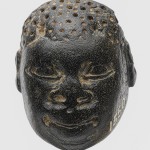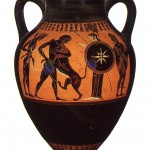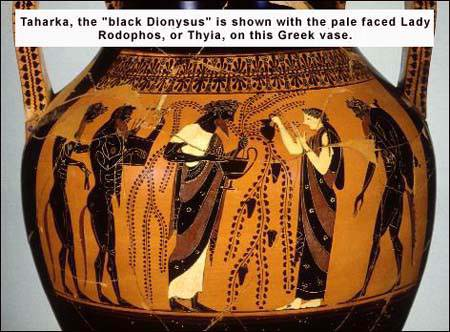
By Jide Uwechia with cited sources
The Benin Haplogroup or Haplogroup 19 Common in Africans, southern Greeks, Sicilians, and Albanians
There are at least four distinct African, (known as Senegal, Congo, Benin, Bantu Hbs Haplogroups) and one Asian chromosomal backgrounds (haplotypes) on which the sickle cell mutation has arisen.
The Benin haplotype (which originates from Nigeria, West Africa) accounts for HbS associated chromosomes in Sicily Northern Greece, Southern Turkey, and South West Saudi Arabia, suggesting that these genes had their origin in West Africa. The Asian haplotype is rarely encountered outside its geographic origin because there have been few large population movements and Indian emigrants have been predominantly from non HbS containing populations. Per:Graham R. Serjeant, MD, FRCP, The Geography Of Sickle Cell Disease:Opportunities For Understanding Its DiversityRSITY: http://www.kfshrc.edu.sa/annals/143/rev9239.html
Nigeria, west Africa appears the most logical origin of the sickle mutation in Greece evidence from beta S globin gene cluster polymorphisms (1991). It has been conclusively demonstrated that HbS in Greece is mostly haplotype #19 (the one that originated in Benin, Nigeria West Africa). See, Boussiou M, Loukopoulos D, Christakis J, Fessas P.; The origin of the sickle mutation in Greece; evidence from beta S globin gene cluster polymorphisms. Unit for Prenatal Diagnosis, Laikon Hospital, Athens, Greece.
Additionally, previous data suggest that the S/Bantu haplotype (from Southern Africa) is heterogeneous at the molecular level. Recent studies also report a similar heterogenity for the Benin Haplogroup. A study demonstrated the presence of the A -499 TA variation in sickle cell anemia chromosomes of Sicilian and North African origin bearing the S/Benin haplotype (from Nigeria). Being absent from North American S/Benin chromosomes, which were studied previously, this variation is indicative for the molecular heterogeneity of the S/Benin haplotype. Am. J. Hematol. 80:79-80, 2005.
A study was done in Albania (which borders Greece) relating to sickle cell anemia, sickle cell beta-thalassemia, and thalassemia major in Albania. The focus of the study was the characterization of sickle cell mutations. As one would expect, it was shown that the HbS mutation in the Albanian sample is the Benin (Nigeria)-originating haplotype #19. See, Boletini E, Svobodova M, Divoky V, Baysal E, Dimovski AJ, Liang R, Adekile AD, Huisman TH.; Sickle cell anemia, sickle cell beta-thalassemia, and thalassemia major in Albania: characterization of mutations. : Hum Genet. 1994 Feb;93(2):182-7.
According to a study done in 1973, before the availability of the advanced data cited above, “the occurrence of the sickle-cell trait in southern Europe …. is believed to reflect gene flow from the Middle East.” See A. P. GELPI, M.D, “Migrant Populations and the Diffusion of the Sickle-Cell Gene” August 1, 1973 vol. 79 no. 2 258-264 http://www.annals.org/content/79/2/258.abstract.
The problem with this 1973 study is that it assumes that the sickle cell genes came with the Arabs. Alas, updated research work has proven beyond doubt that the sickle cell genes proven to exist in southern Europe are exclusively Sickle cell gene Haplotype 19 or the Benin Sickle cell gene from Nigeria.
Y Haplogroup E-M78 and YAP In Black Africans and Greeks
Y Haplogroup E-M78 a derivative of E3B is a signature African gene as confirmed in research studies over the last few years. The high frequency of this haplogroup in Greece suggests the presence of a substantive African population in that region during prehistoric and historical time periods.
A recent paper has detected clades of haplogroups J and E3b that were likely not part of pre-historic migrations into Europe, but rather spread by later historical movements. Greeks .. [then there is] the marker J-M267, which may reflect more recent Middle Eastern admixture.
(Semino et al., Am J Hum Genet, 2004) E3b originates from East Africa while there is a high frequency of J-M267 in the East Coast of Africa as well as the Red sea coast of Arabia.
A recent sampling of the Greek population comprised 36 Peloponnesian samples, 5 of which were J-M172(xM12) and 17 of which were E-M78 (R.K., unpublished data).
In spite of the small Peloponnesian sample size, the high E-M78 frequency (47%) observed here is consistent with that (44%) independently found in the same region (Di Giacomo et al. 2003) for the YAP chromosomes harboring microsatellite haplotypes A. (Novelletto, personal communication) (Cruciani et al. 2004).
The study by by Di Giacomo et al. found the following African haplogroups in Greeks: Haplogroup A which is highly specific to West Africa, R1a, DE, and J2*(xDYS413= 18)J*(xJ2). R1* which probably gave rise to R1a is found in Northern Cameroon. DE is found principally among Nigerians and it is suspected that it originated from Nigeria. J is very prominent in East, and North Africa.
High-resolution Y-chromosome haplotyping and particular microsatellite associations reveal … an East Africa homeland for E-M78.Origin. See Ornella Semino, Chiara Magri, et al “Diffusion, and Differentiation of Y-Chromosome Haplogroups E and J: Inferences on the Neolithization of Europe and Later Migratory Events in the Mediterranean Area” http://www.pubmedcentral.nih.gov/articlerender.fcgi?tool=pubmed&pubmedid=15069642
HLA Genetic Relationship Between Ancient Greeks and Black Africans
HLA genes are reliable markers of past population movement and are still used in laboratories today to establish genetic inter-relationship amongst seemingly diverse peoples.
HLA genes in Macedonians and the sub-Saharan origin of the Greeks (2001) was a study conducted by Dr. Arniaz and other scholars in a top flying Spanish University. This study uses HLA genes to establish the African dimension of the roots of ancient Greece.
According to the Arniaz study, …Greeks are found to have a substantial relatedness to sub-Saharan (Ethiopian) people, which separate them from other Mediterranean groups. Both Greeks and Ethiopians share quasi-specific DRB1 alleles, such as *0305, *0307, *0411, *0413, *0416, *0417, *0420, *1110, *1112, *1304 and *1310. Genetic distances are closer between Greeks and Ethiopian/sub-Saharan groups than to any other Mediterranean group and finally Greeks cluster with Ethiopians/sub-Saharans in both neighbour joining dendrograms and correspondence analyses. The time period when these relationships might have occurred was ancient but uncertain and might be related to the displacement of Egyptian-Ethiopian people living in pharaonic Egypt. See Arnaiz-Villena A, et.al: HLA genes in Macedonians and the sub-Saharan origin of the Greeks. Tissue Antigens. 2001 Feb; 57(2): 118-27
There is a fraudulent claim (by those with idealogical investments in the topic) on the Internet that this study has been “retracted” or “refuted.” The study is perfectly valid. Sub-Saharan-specific and quasi-sub-Saharan-specific alleles were definitely detected in the Greek population at the DRB1 locus, and this is not open to question.
It would be helpful here to discuss the study that was retracted, and the reason why. It is the work titled: “The origin of Palestinians and their genetic relatedness with other Mediterranean populations” (which contained some cross-referenced Greek data in a neighbor-joining dendogram and a correspondence analysis) that was retracted. And it was retracted solely and strictly for political reasons, as this Observer article makes crystal clear:
http://www.guardian.co.uk/Archive/Article/0,4273,4307083,00.html
(Keep in mind we are dealing with the study on the relatedness of Jews and Palestinians at the moment, which was retracted, and not the one on the Greek-Black African relatedness, which was not retracted and remains valid. The two must not be confused.)
Appreciations to: http://onedroprule.org/about1071.html
Epilogue:
“Hb S is common in some areas of the Mediterranean basin, including regions of Italy, Greece, Albania and Turkey (Boletini et al., 1994) (Schiliro et al., 1990). Haplotype analysis shows that the Hb S in these areas originated in Africa. The genes probably moved along ancient trading routes between wealthy kingdoms in western Africa and the trade centers in the Mediterranean basin.” (Harvard University, http://sickle.bwh.harvard.edu/scdmanage.html)
“Usually, people with sickle cell disease outside Africa (e.g., blacks in the United States) or India have mixed haplotypes for their sickle cell genes.” (Harvard University, http://sickle.bwh.harvard.edu/scdmanage.html)
“Templeton gives a modern-day analogy: the presence of a gene for sickle cell anemia in Caucasians in Portugal. The gene traces back to a mutation that occurred in Africa and spread through interbreeding between Africans and Europeans. “The Africans didn’t come up, reconquer the Iberian peninsula, kill off all the Europeans, and that’s why there are sickle cell alleles in Portugal today,” he says. The presence of the sickle cell gene in Portugal “means that Portuguese and Africans have met and they’ve interbred, just like humans tend to do.” – “Out of Africa” – Ruth Flanagan, Contributing Editor, Earth Magazine, http://www2.mc.maricopa.edu/anthro/l…ofAfrica5.html




I always suspected there was more to this ancient Greek story. If they carry so many Nigerian specific genes, then they must have descended from those ancient Nigerians.
Is that why Leo Frobenius and others like him swore that the arts and religion of the Nigerian Yorubas were remarkably similar in concept, style and execution as the early Greek arts?
Is that why the terra-cotta art work of the Nok culture of Nigeria appears like the prototype of Greek terra-cotta art?
One lives and learns everyday.
One Love
Jahdey
Jahdey
Jide:
This is alarmingly shocking!
This is a bunch of historical revisionist tripe. It can also be called historical reaqusition where one group overlays false claims with dubious historical and scientific claims to aquire the historical heritage of another group. It is often an overcopensation for a sence of cultural inferiority.
Jon Eills
Relax relax don’t lose yur cool. No need to squeak like a frightened rat.
What you see on the article here is a bold claim backed by irrefutable scientific evidence, further bolstered by textual and graphic evidence coming from the agean and the Greek Islands.
What is your issue? Marshal out your points and refute the arguments. Save us your angst, your hate and your bitterness.
Focus on the work and debunk the facts on its logic and coherence if you can…if you dare…if you have the light of intelligence in you.
Jahdey
“In my own skeletal samples from Greece I note apparent negroid nose and mouth traits in two of fourteen Early Neolithic, only two or three more among 364 from fifth to second millenium B.C., one among 113 Early Iron Age, one or two among 233 Classic and Hellenistic skeletons, but four Negroids (all from one area of Early Christian Corinth) among ninety-five Roman period, two among eighty-five Medieval, and of course ten among fifty-two Turkish period Greeks, yet none among 202 of Romantic (nineteenth century) to date.”( J. Lawrence Angel: American Anthropologist, New Series, Vol. 74, No. 1/2 (Feb. – Apr., 1972),
To break it down:
Only TWO among 14 during the Early Neolithic period, pretty low contribution for a population that is said have ‘started’ it all
Only TWO or THREE among THREE HUNDRED & SIXTY FOUR between the fifth to second millenium B.C(Minoan time line). Again very low contribution if only a few have been found among HUNDREDS that don’t exist for a society that some have been falsely claiming were the originators of European civilization.
Only ONE among ONE HUNDRED & THIRTEEN during the Iron Age(The Iliad time line), again very low contribution.
Only ONE or TWO among TWO HUNDRED & THIRTY-THREE from the Classical to the Hellenistic period(that ends when Rome takes over Hellenic world) again low contribution.
Only FOUR among NINETY-FIVE from the Roman period and they all came from the same area, again very low contribution.
Only TWO among EIGHTY-FIVE during the Medieval period of Greece, again low contribution.
TEN among FIFTY-TWO during TURKISH period
ZERO, NONE, ZIP, NADA findings among TWO HUNDRED and TWO of Romantic (nineteenth century) to date aka in MODERN TIMES.
Conclusion: since Early Neolithic period African blacks were not the contributors of European / Aegean civilizations as some falsely claim.
Andrea
You are citing a 1972 work ( J. Lawrence Angel: American Anthropologist, New Series, Vol. 74, No. 1/2 (Feb. – Apr., 1972), to refute a series of research done between 1991 to 2005? (example: Am. J. Hematol. 80:79-80, 2005; Hum Genet. 1994 Feb;93(2):182-7; etc)
What wretchedness. You are so desperate to smear Black African history with your neo-nazi hogwash that you would resort to the lowly tactis of using outdate research works to debunk new findings just rolling out of the fields and the labs? Again what a pitiful soul you are.
You mean you have never realize that science is incremental in knowledge and dated works cannot stand before their updated and corrected versions?
The article in the main post discusses about recent findings 1991 to 2005. In rebutal you cite research work done in 1971!!!
You are as outdated as your anachronistic sources. You have again shown yourself to be an irrelevant, illiterate, racist troll seeking attention on this site.
It is clear you really have nothing to contribute but distraction and as such I am asking the moderator to ban you and your lower life trolling types from this site.
Jahdey
Oxford University geneticist Stephen Oppenheimer (author of ‘The Seven Daughters of Eve’, and ‘The Origins of the British’) has done research that proves that all of humanity came from a mass exodus from sub-Saharan (black) Africa. Thus all humans on earth, whether past, present, or future, have black DNA at various degrees. So I don’t believe that these studies are trying to rob Europeans or Arabs of their accomplishments.